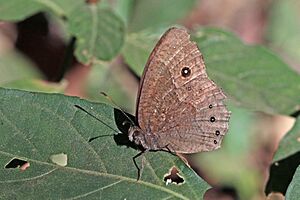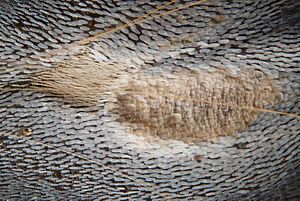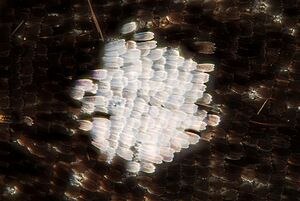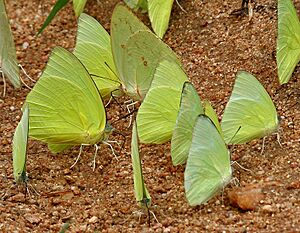Squinting bush brown facts for kids
Quick facts for kids Squinting bush brown |
|
|---|---|
 |
|
| B. a. anynana, Harenna Forest, Ethiopia | |
| Scientific classification | |
| Synonyms | |
|
The Bicyclus anynana is a small brown butterfly. It is also known as the squinting bush brown. This butterfly belongs to the Nymphalidae family. This family has the most types of butterflies in the world. You can mostly find it in eastern Africa. It lives from southern Sudan all the way to Eswatini. These butterflies prefer to live in woodland areas. They usually fly close to the ground. Male butterflies have wings that are about 35–40 mm wide. Females have slightly larger wings, about 45–49 mm wide.
The squinting bush brown is very useful for scientists. Its size and how fast it breeds make it great for studies. This butterfly can also change its colors depending on the season. This makes it a perfect example for studying phenotypic plasticity. This means how an organism changes its traits based on its environment. Butterflies in the wet season have big eye-like spots. Those in the dry season have duller colors.
Contents
What Does It Look Like?
The squinting bush brown is a small brown butterfly. Males have a wingspan of 35–40 mm. Females are a bit larger, with wingspans of 45–49 mm. Males have special parts on their wings called androconia. These release scents to attract females.
These butterflies have short front legs. Their brown wings are not very flashy. But in the wet season, they are known for having several large eyespots. There are two main groups each year. The wet-season form flies in spring and summer. The dry-season form is seen in autumn and winter.
Why Is This Butterfly Important for Research?
Scientists first collected the bush brown to study how living things change over time. They also looked at how they fit into their environment. Now, this research mainly helps us understand how the environment shapes the butterfly's traits.
The squinting bush brown is a great butterfly for studies. Its small size makes it easy to raise and care for. Yet, it is big enough for scientists to tag and study closely. These butterflies show phenotypic plasticity. This means their life habits, wing patterns, and seasonal changes can vary. Also, their entire genetic code has been mapped. This makes them perfect for learning how the environment affects genes.
Where Does It Live?
The squinting bush brown is part of the Bicyclus genus. It belongs to the Nymphalidae family. It is also in the order Lepidoptera, which includes all butterflies and moths. There are three different types, or subspecies, of this butterfly. These are B. anynana anynana, B. a. centralis, and B. a. socotrana.
You can find the squinting bush brown in eastern Africa. B. a. anynana lives in countries like Kenya, Tanzania, and Ethiopia. It is also in Zambia, Malawi, Mozambique, Zimbabwe, Botswana, South Africa, and the Comoro Islands. B. a. centralis is found in Uganda, southern Zaire, eastern Zaire, and northern Angola. Bicyclus anynana socotrana mostly lives on Socotra Island.
This butterfly is common and widespread. So, its conservation status is secure. It does not need any special protection.
Life Cycle
The squinting bush brown can live up to six months in the wild. It becomes an adult in about two weeks.
The young larvae (caterpillars) eat many kinds of grass. They also eat a few types of cyperus plants.
-
Egg on a corn (Zea mays) leaf with a tiny caterpillar inside.
Habitat and Feeding
Squinting bush browns are usually woodland butterflies. They fly close to the ground. They are mainly found in eastern Africa. This includes countries like Uganda, Ethiopia, Kenya, Tanzania, Mozambique, and Zimbabwe.
When they are caterpillars, they eat several types of grass. Adult butterflies eat fruit that has fallen to the ground. Butterflies that eat fruit often live longer. They eat fruit because it is available. Studies show that butterflies eating fruit have healthier offspring.
Mud Puddling
Male squinting bush browns are known to do something called mud puddling. This is a special way of feeding. The butterflies gather on wet soil or animal waste. They take in nutrients and salt from these spots. Only male butterflies do this. Females that mate with males who have been puddling do not seem to get any special benefits for their offspring.
Reproduction and Mating
Male butterflies follow six steps to mate with a female. These steps are finding her, getting into position, flickering their wings, moving closer, trying to mate, and then mating. Males attract females using many androconia on their wings. These spots release special scents called pheromones. The flickering of their wings helps spread these scents in the air.
During mating, males give females spermatophores. These are packets that contain nutrients. These nutrients help the females produce more healthy eggs.
Butterflies that become adults in the wet season reproduce quickly. Those that become adults in the dry season use their energy to survive longer. During the dry season, females tend to lay fewer but larger eggs. This means they put more effort into each single offspring. This trait is important for studying phenotypic plasticity.
How Temperature Affects Male Courtship
The way male butterflies court females can change. This is called courtship rate plasticity. It means their mating behavior changes based on things like temperature. Studies show that male squinting bush browns change their courtship rate. This depends on the temperatures they experience from their caterpillar stage to adulthood.
Scientists looked at when this change in courtship rate happens. They found that high temperatures (around 27 degrees Celsius) made males court females more. But low temperatures (17 degrees Celsius) made males court females much less. This shows how butterflies adapt to their environment.
This change in courtship only happens if the butterfly experiences different temperatures during its pupal stage and as an adult. The temperature during the caterpillar stage does not affect it. Scientists think that adult temperature matters because behavior can keep changing as they grow. Another idea is that temperature affects how well adults can move.
Researchers at Yale University found that the temperature where caterpillars grow affects the adult butterfly's behavior. Females raised in cooler places are more likely to actively court males. In warmer places, males usually take the lead in courtship.
Older Male Advantage
In squinting bush brown butterflies, older males seem to have an advantage when it comes to mating. There are two main ideas why this might happen. First, older males might be more determined to mate. They have less time left to reproduce. Second, females might prefer older males. If an older male has survived for a long time, he likely has good genes. Females might choose to mate with him to pass these good genes to their offspring.
Inbreeding and Its Effects
Squinting bush browns are one of the first insects where scientists saw clear problems from inbreeding. Inbreeding happens when closely related butterflies mate. When this happens, fewer eggs hatch. Also, the adult butterflies that do hatch often have problems with their development. They might also have trouble laying eggs themselves.
However, if these butterflies are allowed to breed freely, they can recover from inbreeding problems in a few generations. Female butterflies do not naturally avoid their siblings when choosing a mate. This suggests that in nature, meeting relatives might be rare. So, they might not need to avoid inbreeding actively.
Eyespots
Eyespots and Mating
Female butterflies also choose a mate based on their eyespots. They look at how large and bright the UV reflective centers of the eyespots are. Eyespots that are either too big or too small are not preferred. This is called stabilizing selection. Scientists believe that females choosing mates, rather than avoiding predators, has led to this specific eyespot size.
Eyespots for Defense
Like many butterflies, the squinting bush brown uses the eyespots on its wings for defense. There are two main ideas about why these eyespots developed. The first idea is that large eyespots look like the eyes of a predator's enemy. This can surprise a predator for a moment, giving the butterfly time to escape.
The second idea is that eyespots on the edges of the wings draw attention to parts that are not vital. A bird might attack the wings instead of the body. If the first attack fails, the butterfly can often escape. These eyespots work best against birds, which are common predators of the bush brown.
Eyespots and Seasonal Change
The size of the eyespots on the squinting bush brown changes with the seasons. This is another example of phenotypic plasticity. During the African wet season, they have large, clear eyespots. But in the dry season, their eyespots are much smaller.
Caterpillars growing in the dry season can develop traits like the wet-season butterflies. And caterpillars from the wet season can have traits like the dry-season butterflies. This adaptation helps them survive. It is better to be less noticeable during the dry season. This way, they can blend in with the brown surroundings. During the wet season, there is a lot more plant life. So, the eyespots are useful for distracting predators.










